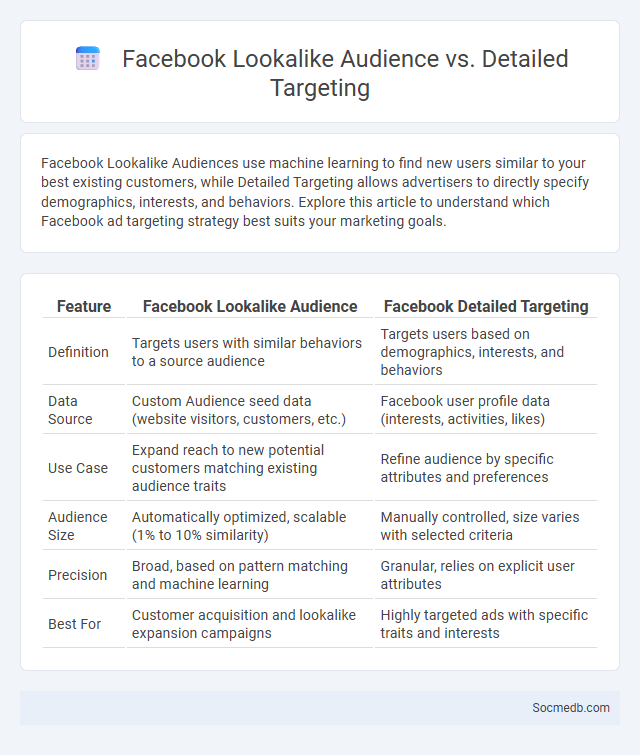
Photo illustration: Facebook Lookalike Audience vs Detailed Targeting
Facebook Lookalike Audiences use machine learning to find new users similar to your best existing customers, while Detailed Targeting allows advertisers to directly specify demographics, interests, and behaviors. Explore this article to understand which Facebook ad targeting strategy best suits your marketing goals.
Table of Comparison
| Feature | Facebook Lookalike Audience | Facebook Detailed Targeting |
|---|---|---|
| Definition | Targets users with similar behaviors to a source audience | Targets users based on demographics, interests, and behaviors |
| Data Source | Custom Audience seed data (website visitors, customers, etc.) | Facebook user profile data (interests, activities, likes) |
| Use Case | Expand reach to new potential customers matching existing audience traits | Refine audience by specific attributes and preferences |
| Audience Size | Automatically optimized, scalable (1% to 10% similarity) | Manually controlled, size varies with selected criteria |
| Precision | Broad, based on pattern matching and machine learning | Granular, relies on explicit user attributes |
| Best For | Customer acquisition and lookalike expansion campaigns | Highly targeted ads with specific traits and interests |
Introduction to Facebook Advertising Targeting Options
Facebook advertising targeting options include demographic, interest, and behavior-based filters that allow advertisers to reach specific audiences with precision. Custom Audiences enable marketers to retarget existing customers, while Lookalike Audiences help find new users similar to their best customers. These tools optimize ad spend by delivering personalized content to users most likely to engage with the ads.
What is Facebook Lookalike Audience?
Facebook Lookalike Audience is a targeting tool that enables advertisers to reach new users similar to their existing customers by analyzing data patterns such as interests, behaviors, and demographics. By leveraging Facebook's vast user data, businesses can create a custom audience that mirrors high-value customers, increasing the efficiency of ad campaigns and potential conversion rates. This method enhances precision in digital marketing, helping brands expand their reach to users most likely to engage or purchase.
How Detailed Targeting Works on Facebook
Facebook's detailed targeting allows you to refine your audience based on demographics, interests, behaviors, and location data. This precision targeting uses algorithms that analyze user activity, such as page likes, purchases, and app usage, to match your ads with the most relevant users. By leveraging this feature, your campaigns can achieve higher engagement and conversion rates through personalized ad delivery.
Comparing Lookalike Audience vs. Detailed Targeting
Lookalike Audiences use data from your current customers to find new users with similar behaviors, increasing the chances of high conversion rates by targeting people who resemble your best clients. Detailed Targeting allows you to specify demographics, interests, and behaviors, giving you precise control over audience attributes to maximize relevance and engagement. Your choice between Lookalike and Detailed Targeting depends on whether you want to expand reach to similar users or refine audience parameters for tailored campaigns.
Benefits of Using Facebook Lookalike Audiences
Facebook Lookalike Audiences enable precise targeting by identifying users similar to an existing customer base, increasing campaign relevance and engagement rates. This advanced targeting method enhances ad efficiency, often resulting in higher conversion rates and lower cost-per-acquisition. Marketers leverage Lookalike Audiences to scale reach organically and maximize return on investment in social media advertising campaigns.
Advantages of Detailed Targeting on Facebook
Detailed targeting on Facebook enables advertisers to reach specific audiences based on demographics, interests, behaviors, and location, which enhances ad relevance and engagement. This precision reduces ad spend waste by focusing on users more likely to convert, increasing return on investment (ROI) for campaigns. Moreover, access to Facebook's vast data pool allows marketers to continuously refine targeting strategies for improved campaign performance.
When to Use Lookalike Audiences vs Detailed Targeting
Lookalike Audiences are ideal for scaling campaigns by targeting new users who resemble your existing high-value customers, using data from customer lists or website visitors. Detailed Targeting works best when you want to reach specific groups based on demographics, interests, and behaviors, allowing precise control over audience attributes. Use Lookalike Audiences to expand reach efficiently and Detailed Targeting to refine audience segments for tailored messaging.
Combining Lookalike Audience with Detailed Targeting
Combining Lookalike Audiences with Detailed Targeting maximizes the precision of your social media campaigns by reaching users who closely resemble your best customers while narrowing the audience based on specific interests, behaviors, or demographics. This hybrid approach leverages the power of algorithm-driven similarity models and granular filters to enhance ad relevance and improve conversion rates. By integrating these strategies, you improve your ad spend efficiency and significantly increase your return on investment.
Common Mistakes in Facebook Audience Selection
Common mistakes in Facebook audience selection include targeting overly broad demographics, which reduces ad relevance and engagement, and neglecting to use Facebook's detailed interest and behavior filters that optimize reach. Many advertisers also fail to exclude irrelevant or overlapping audiences, resulting in wasted budget and ad fatigue. Proper segmentation using Custom Audiences, Lookalike Audiences, and thorough demographic analysis enhances campaign performance and ROI.
Best Practices for Effective Facebook Audience Targeting
Effective Facebook audience targeting relies on precise segmentation based on demographics, interests, and online behaviors to maximize engagement and conversion rates. Utilize Facebook's Lookalike Audiences feature to reach users similar to your best customers, enhancing ad relevance and ROI. Regularly analyze performance metrics and refine your audience parameters to ensure Your campaigns stay aligned with evolving user preferences and market trends.
 socmedb.com
socmedb.com